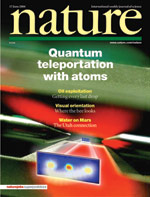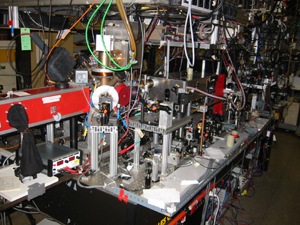Deterministic quantum teleportation with atoms
 For the first time, our team at the Institute for Experimentalphysik at Innsbruck University in collaboration with Daniel James from Los Alamos Laboratory in the USA succeeded at teleporting the quantum state of a trapped calcium ion to another calcium ion. This is the first time teleportation has been achieved with atomic particles, as opposed to beams of light, in an entirely deliberate, controllable manner. Related results are also being reported by the NIST ion storage group at the National Institute of Standards and Technology in Boulder, USA.
For the first time, our team at the Institute for Experimentalphysik at Innsbruck University in collaboration with Daniel James from Los Alamos Laboratory in the USA succeeded at teleporting the quantum state of a trapped calcium ion to another calcium ion. This is the first time teleportation has been achieved with atomic particles, as opposed to beams of light, in an entirely deliberate, controllable manner. Related results are also being reported by the NIST ion storage group at the National Institute of Standards and Technology in Boulder, USA.
The key to quantum state teleportation is a fascinating, peculiar quantum-mechanical link that can be created between two or more particles called entanglement. This notion was introduced by the austrian physicist Erwin Schrödinger to describe the puzzling features of quantum mechanics and led to colourful discussions with Albert Einstein. If particles are entangled, their common quantum state is well known but absolutely nothing is known about the states of the individual particles. Entanglement forms the critical ingredient of a future quantum computer, a revolutionary new technology currently under intense development world-wide. In 1993, an international group of scientists, including IBM's Charles Bennett, proposed a scheme to employ entanglement to teleport the quantum state of one particle to another. At first a theoretical curiosity, various aspects of this teleportation protocol had been demonstrated within a few years by early experiments. However, it required the development of small-scale prototype quantum computers to perform the operation in its entirety. This has now been accomplished in the labs of the Innsbruck Quantum Optics group.
In the experiment, described in the most recent issue of the scientific journal Nature, singly-ionized calcium atoms were confined and cooled to ultra-low temperatures a few millionths of a degree above absolute zero. Using lasers, the internal configurations of the atoms –their quantum states– were controlled very precisely, allowing entanglement between two of the atoms to be created. One of these entangled atoms is then further entangled with a third atom--the input of the teleporter. By performing a simple measurement on this pair, and a series of laser pulses dependent on the outcome of the measurement, the original input state could be re-created on the remaining output atom.
The significance of these results is that they represent a major step towards making quantum information processing a reality. This is a technology that exploits the fundamental properties of quantum mechanical systems –the very properties that make them different from phenomena encountered in everyday life– in order to compute or communicate far more efficiently than is currently possible even with the most advanced super-computers. The use of ion traps as model systems for quantum computers was originally proposed by Peter Zoller and Ignacio Cirac in 1995. The teleportation experiment constitutes another step forward towards more complex small-scale systems.
The first teleportation experiments were done with photons by Anton Zeilinger in Innsbruck, Francesco de Martini in Rome and Jeff Kimble at Caltech.
For details of our experiment, see the commented slide-presentation, read the paper or have a look the accompanying "News and views" article. Here, you will find further pictures of the experiment. There is also the paper of the NIST ion trap group.
"Deterministic quantum teleportation with atoms",
M. Riebe, H. Häffner, C. F. Roos, W. Hänsel, J. Benhelm, G. P. T. Lancaster, T. W. Körber, C. Becher, F. Schmidt-Kaler, D. F. V. James, R. Blatt,
Nature 429, 734 (2004)
 Part of the experimental setup.
Part of the experimental setup.
We are financially supported by Universität Innsbruck, the Austrian research fund (FWF) within the program "Control and Measurement of Coherent Quantum Systems", the European networks QGATES and CONQUEST, IQI, ARO and the Austrian academy of sciences.



